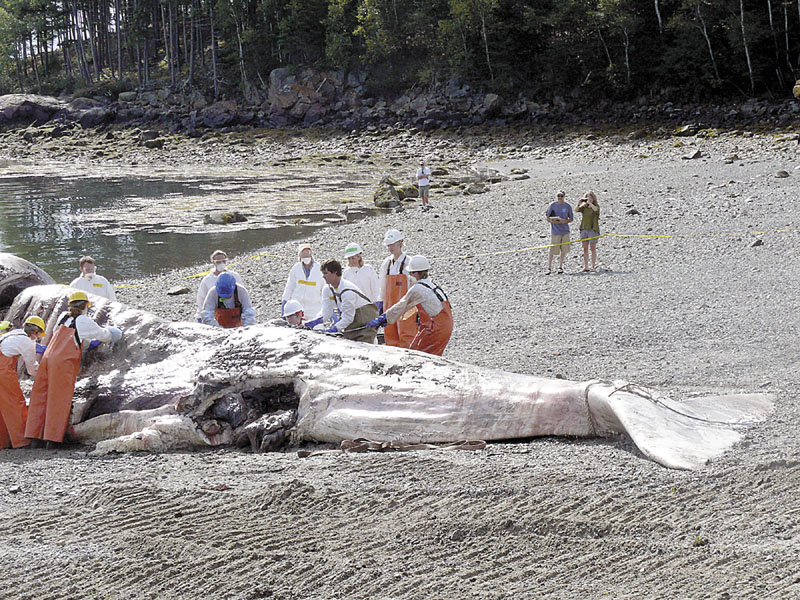A sperm whale carcass, retrieved last week from Frenchman Bay near Bar Harbor, was dismembered as part of a necropsy of the gigantic marine mammal conducted Monday by researchers near Bar Harbor.
It could take seven to eight months to compile results from the necropsy, said Sean Todd, director of Allied Whale, College of the Atlantic’s marine mammal research group. The college, marine sciences students, volunteers and other scientists participated in the procedure.
Marine scientists might never know what caused the whale’s death, said Todd, who was coordinating the gargantuan effort of sectioning off portions of the carcass for study.
The whale — a 10 to 15-year-old male weighing 50 tons and measuring 50 feet long — was found dead, floating in waters off Acadia National Park, by a fisherman on Aug. 13. The following day it was towed in by the College of the Atlantic’s new utility, transport and research vessel. It was dragged tail first, “very slowly” to a private beach, said Donna Gold, director of public relations for the environmental liberal arts college in Bar Harbor.
The effort to determine the cause of death took all day Monday, said Gold. The remains were then removed and taken to a privately owned burial area, where, she said, “we will let the worms and bugs feast on them. And then it’s ready for us.”
That should take 10 to 12 weeks, and even after lengthy burial, the bones will need to be be boiled to further clean them.
“It’s a massive operation; it smells pretty strong,” Todd said by phone from the site of the work, which started at 10 a.m. and was aided by operators of a backhoe, roll-off loader and several flat bed trucks. “We got through the really gross part,” he said, adding that the odor diminished as the day wore on and the process continued.
The necropsy involved severing the whale’s head, weighing about 30,000 pounds, from the body for study, and then cutting the remaining 70,000-pound trunk-to-tail portion into smaller pieces to make it easier to haul away.
Allied Whale, which is part of the Marine Mammal Stranding Network, is operated by the National Oceanic and Atmospheric Administration. The program, which extends from Rockland to the Canadian border, intends to “collect as much scientific information as possible” and to reconstruct the skeleton for display at the Bar Harbor Whale Museum, said Todd.
The impressive skeleton will be used to raise money for the museum and attract new donors.
“I am guilty of using whales as poster children to talk about marine conservation,” said Todd. Humans “haven’t done a terribly good job” of managing the world’s oceans, and to get the conversation going about how better to do that, he said, “nothing grabs the attention like a 50-foot carcass.”
The bones were in “extremely good condition,” which pleased marine scientists and researchers, because the intact skeleton constitutes an extremely rare and valuable find, Todd said.
The scientists and other workers created teams of four to six people for the necropsy, and two teams at a time worked on the carcass, Gold said. They had to cut through substantial fat on the carcass, which had been decomposing for about two weeks, before reaching a muscle layer a foot thick.
Send questions/comments to the editors.



Comments are no longer available on this story